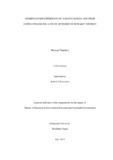
Please use this identifier to cite or link to this item:
https://hdl.handle.net/20.500.14301/223| Title: | WOMEN’S LIVED EXPERIENCE OF CLIMATE CHANGE AND THEIR COPING STRATEGIES: A STUDY OF WOMEN IN NUWAKOT DISTRICT |
| Authors: | Thapaliya, Bhawani |
| Citation: | THapaliya, B.(2013).Women’s lived experience of climate change and their coping strategies: A study of women in Nuwakot district. |
| Issue Date: | Jul-2013 |
| School: | SOED |
| Department: | DODE |
| Level: | Masters |
| Program: | KUMSD |
| Abstract: | This study attempts to bring forth women’s lived experience of climate change and their meaning making process about it. Principally, it explores the contextual determinants and dimensions of women’s understanding of, and response to, climate change. The study has employed qualitative approaches in order to give an insight into how women construct discourses of understanding climate change and their actions against it. Furthermore, it tries to answer the questions; who is more vulnerable and why, what are the local and institutional coping mechanisms, and what are the constraints that exacerbate vulnerability. The study uses un-structured interview as a tool to garner data from the local level. The analysis suggests that the impact of climate change is ubiquitous including climate variability, rainfall pattern, plant phenology etc. Precipitation is becoming unpredictable and more erratic. Similarly, women were experiencing an increment in temperature. Although women in the study area have been observing these changes for years, they have little understanding of the anthropogenic causes of ii these changes. Their observations and interpretations of the situation largely corroborate the divinity. The study further reveals that the impact of climate change is felt in agriculture, livestock rearing and water resources. Amongst its impact, agriculture is one of the sectors most vulnerable. Many of the local varieties of agro-biodiversity, livestock have already been extinct and some are in the threshold of extinction. The trend of using chemicals, pesticides and outsourced seed varieties to suffice the production was prevalent in the study area. Indeed, input on agriculture was high whereas its output was negligible. This has further weakened their economy. Climate change and climate impacts are not gender neutral. The impact is even stronger on those women who totally rely on agriculture for the daily subsistence, and where adaptive capacity is low. Furthermore, socially constructed roles and responsibilities of women and their less access to decision making process makes them more susceptible to climate change impacts than men. As, migration has emerged as a cross cutting issues of climate change, it has further increased women’s vulnerability because of being overburdened by triple roles, i.e. production, reproduction and household chores. As coping strategies, mainly mitigation and adaptation have emerged in the arena of climate change. In adapting to climate change women cultivate varieties of crops which are drought tolerant. Additionally, they have replaced local livestock varieties with hybrid ones and similarly, the livelihoods have been diversified towards off-farm activities. Moreover, visions and potential solutions, and also support for the strong policy diversify their livelihood due to the low production from their agricultural land. The result shows that the existing local and institutional strategies iii are not sufficient and sustainable to cope with climatic vagaries. Therefore, it is crucial to increase the understanding of the actual climate change dynamics in the societies at the lower levels. Keywords: Climate change, vulnerability, coping mechanism; mitigation, adaptation |
| URI: | https://hdl.handle.net/20.500.14301/223 |
| Appears in Collections: | Research Project |
Files in This Item:
| File | Description | Size | Format | |
|---|---|---|---|---|
| Bhawani Thapaliya.pdf | 1.23 MB | Adobe PDF |  View/Open |
Items in DSpace are protected by copyright, with all rights reserved, unless otherwise indicated.